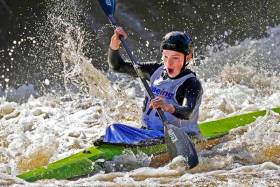Displaying items by tag: Canoe Marathon
#Canoeing: Ronan Foley took gold medals on Saturday and Sunday at the canoe marathon World Cup in in Viana do Castelo in Portugal. The Kilcullen man dominated the short race on Saturday, and then sprinted away from his rivals on the last portage to win the marathon test on the Sunday.
Barry Watkins took silver in the senior race over the short course on Saturday and took 10th on Sunday – recovering from an unwanted swim in rough conditions.
Canoe Marathon World Cup, Viana Do Castelo, Portugal (Irish interest; selected results):
Saturday
Men – K1 Short Race: 2 B Watkins 13:46.15.
K1 Short Race, Juniors: 1 R Foley 14 min 52.43 sec.
Sunday
Men – K1 Marathon: 10 Watkins 2 hr 21 min 10.20.
K1 Marathon, Junior Final: 1 Foley 1 hr 53 min 7.34 sec.
Jenny Egan Fourth at Canoe Marathon World Championships
#Canoeing: Jenny Egan finished fourth in the senior K1 event at the Canoe Marathon World Championships in Gyor in Hungary. Anna Koziskova of the Czech Republic took gold, covering the 26.1 kilometre course in one hour 56 minutes 28.847 seconds, while Egan was three minutes and just under 50 seconds further back. Egan was 57 seconds behind bronze medallist Kristina Bedec of Serbia.
Canoe Marathon World Championships, Gyor, Hungary
Men
K1 Senior, 30km: 25 P Egan 2 hrs 15 min 24.477sec ; B Watkins dnf. K1 Under-23, 26.1km: 18 T Brennan 1:56.378.177
Women
K1 Senior, 26.1km: 4 J Egan 2:00.18.166.
























































